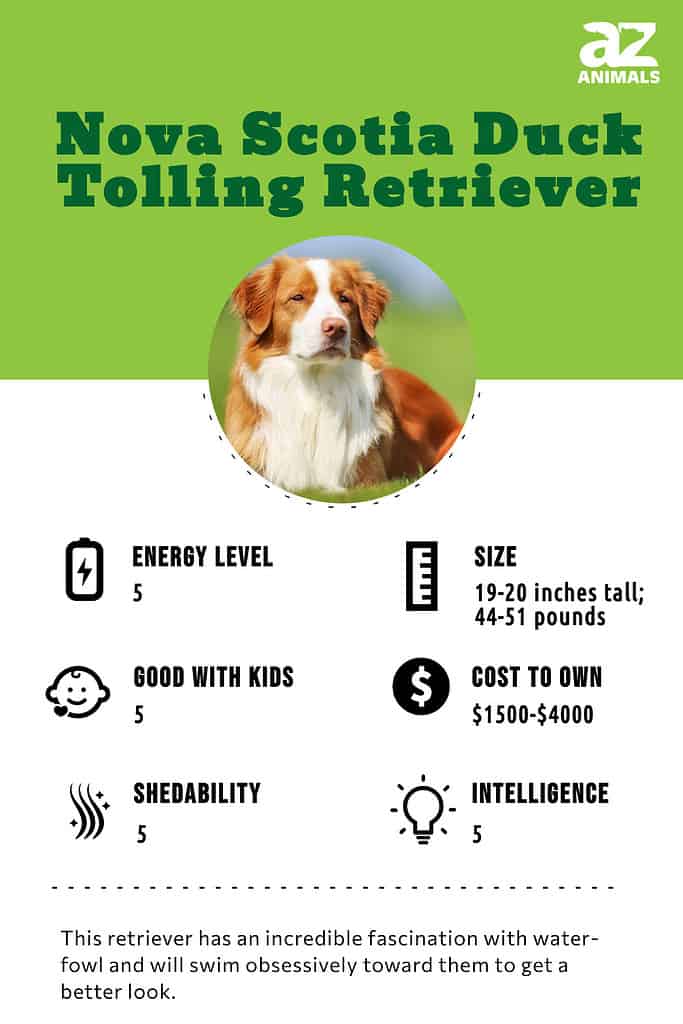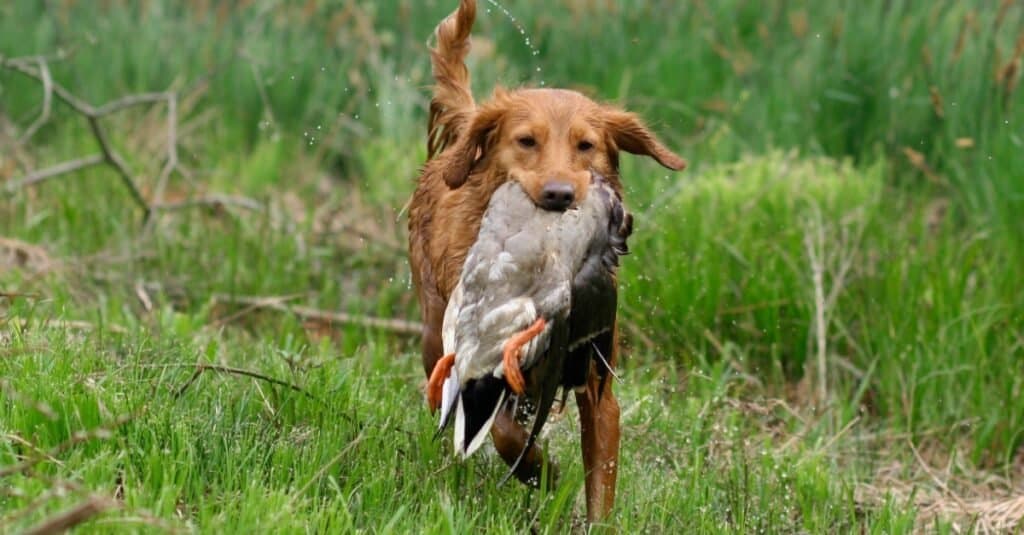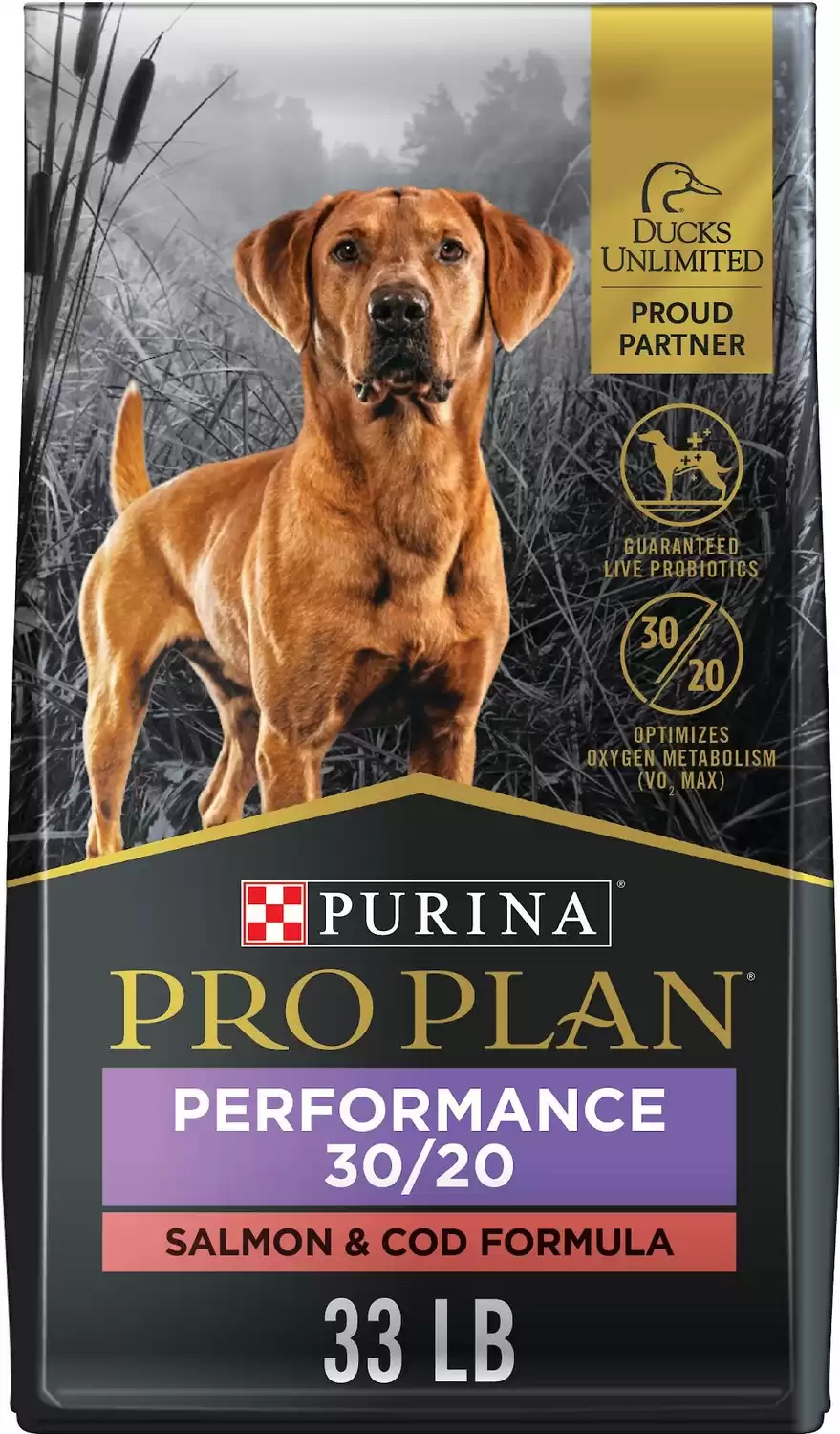Nova Scotia Duck Tolling Retriever
Canis lupus
The Toller is one of only two breeds that hunters use as decoys while hunting.
Advertisement
Nova Scotia Duck Tolling Retriever Facts
- Fun Fact
- The Toller is one of only two breeds that hunters use as decoys while hunting.
- Temperament
- Energetic and friendly, they make a great choice for families that can meet their exercise needs.
- Diet
- Omnivore
Nova Scotia Duck Tolling Retriever as a Pet:
- General Health
- Energy Level
- Shedability
- Trainability
- Intelligence
- Tendency to Chew
- Size
- Family and kid friendliness
- Yappiness / Barking
- Moderate
- Separation Anxiety
- Moderate
- Preferred Temperature
- Cold climate
- Exercise Needs
- High
- Friendly With Other Dogs
- High
- Pure bred cost to own
- $1500 to $4000
- Dog group
- Sporting
- Male weight
- 44-51 lbs
- Female weight
- 37-44 lbs
This post may contain affiliate links to our partners like Chewy, Amazon, and others. Purchasing through these helps us further the A-Z Animals mission to educate about the world's species.
View all of the Nova Scotia Duck Tolling Retriever images!
The Nova Scotia Duck Tolling Retriever is one of only two breeds that hunters use as decoys while hunting.
The Nova Scotia Duck Tolling Retriever, also known as the Toller, was bred to use when hunting waterfowl. The behavior used when hunting is known as tolling, which is how the breed earned its name.
See all of our expert product reviews.
When tolling, the hunter positions himself in a blind and sends the dog out to play along the water’s edge. When curious geese and ducks move in to take a closer look at what is going on, the hunter calls the dog back and shoots. The dog then retrieves the waterfowl.
This interesting fact sets the Toller apart from other retrievers who only retrieve the hunter’s prey. The Toller actively acts as a decoy, luring the waterfowl closer. In this way, the Toller’s behavior resembles that of the fox, who work in pairs hunting along the water’s edge.
The breed developed from a combination of other hunting breeds, such as spaniels, retrievers, and setters. He is shorter in height and lighter in weight than other retriever breeds, thanks to the Spaniel’s influence. While hunting waterfowl is bred into his genes, the breed is also a confident, happy breed that makes an excellent companion.

Different Nova Scotia Duck Tolling Retriever Mixes
The Toller is a rare breed, so most breeders choose to preserve the bloodline. However, occasionally the Toller is crossed with the German Shorthaired Pointer, with the resulting pups known as German Shorthair Tollers.
History Of The Breed

Nova Scotia duck tolling retrievers almost went extinct in the 20th century.
Health and Entertainment for your Nova Scotia Duck Tolling Retriever
See all of our expert product reviews.
©Marina Plevako/Shutterstock.com
The Nova Scotia Duck Tolling Retriever was first developed in the early part of the 19th century in Little River Harbor in Yarmouth County Nova Scotia, Canada. While there are no breeding records of this dog’s early history or who began to breed it, it is believed that they were farmers and fishermen. They also go by the name of Toller Dog and Little River Duck Dog. This retriever was almost extinct in the 20th century due to a dwindling stock and more of an interest in using the dogs as hunters and not breeders. In 1973, the Nova Scotia Duck Trolling Club was formed by Sue Van Sloun in an effort to save the breed. Not only did the club help this dog make a comeback but in 2003, the breed was officially recognized by the AKC.
3 Pros And Cons Of Owning A Nova Scotia Duck Tolling Retriever
| Pros! | Cons! |
|---|---|
| Happy and good-natured | Requires plenty of exercise |
| Excellent for obedience and agility competitions | Can chew, dig, or otherwise be destructive when bored |
| Generally a hardy breed | Double-coat requires regular grooming |

©iStock.com/Azoogle
Size And Weight
The Nova Scotia Duck Tolling Retriever is a medium-sized dog and is the smallest of the retrievers. Although he is often mistaken for a Golden Retriever, not only is he smaller, but also has a foxy, wedge-shaped head, while the Golden’s is blocky.
| Height (Male) | 20″ |
| Height (Female) | 19″ |
| Weight (Male) | 51 lbs |
| Weight (Female) | 44 lbs |
Common Health Issues
There are a few health conditions that the Toller is prone to. They include Addison’s disease, hypothyroidism, hip dysplasia, and progressive retinal atrophy. The same genetics that gives the Toller his red coat and nose make him prone to immune-mediated disease.
Temperament

Nova Scotia Duck Tolling Retriever has an affectionate temperament and is good with children.
©Zuzanna Paluch/Shutterstock.com
Tollers have an energetic, affectionate temperament. Good with children and pets, they make a fine companion for households that can provide the exercise needed to keep them happy.
How To Take Care Of A Nova Scotia Duck Tolling Retriever
The Toller is a sporting dog that requires plenty of activity. As long as he gets his exercise needs met, he is a pretty low-maintenance companion. While shedding is common, it is no worse than many other breeds. The main concern with the breed is his tolerance for heat. Although he does fine in cold and temperate climates, his double coat makes him ill-suited for long stretches of hot weather.
The Best Dog Food For Nova Scotia Duck Tolling Retrievers

The toller needs high-quality food, like a diet high in protein, to maintain a healthy weight.
©Zuzanna Paluch/Shutterstock.com
As an active, energetic breed, the Toller needs high-quality food to maintain a healthy weight. As an adult, breaking his food up into two meals a day improves digestion and can prevent him from eating too quickly. As he ages, he may start to put on some pounds. Keep an eye on his weight to prevent obesity, which further strains this breed’s joints and has a negative effect on overall health.
One of the best ways to assure a healthy weight for Nova Scotia Duck Tolling Retrievers is a high-protein diet that promotes lean muscle.
So, at A-Z Animals, we think the best dog food for Nova Scotia Duck Tolling Retrievers is Purina Pro Plan Sport Performance 30/20 Salmon & Cod Formula.
The 30/20 protein-to-fat balance in this high-performance dog food not only keeps dogs like the Nova Scotia Duck Tolling Retriever in good shape, but it’s also ideal for dogs that are vulnerable to autoimmune diseases like an immune-mediated disease. Plus, this food’s glucosamine, omega 3 fatty acids, and EPA are good for the joints, while Vitamin A supports healthy, clear eyes.
Get Purina Pro Plan Sport Performance 30/20 on Chewy and Amazon.
- Purina Pro Plan Sport Performance 30/20 Salmon & Cod Recipe
- High protein dog food contains 30% protein and 20% fat for lean muscle and metabolism needs
- Glucosamine and EPA for joint health and mobility
Maintenance And Grooming
The double coat of the Toller does require some care. Brushing a few times a week should be enough to keep his shedding under control. Take special care to brush in the armpits and between the back legs, as the friction from motion in those spots make it easy for mats to quickly form.
Training

The toller was bred to work alongside humans and is agile and devoted.
©iStock.com/cynoclub
The Toller is an intelligent breed that was bred to work alongside humans. Training is generally straightforward, although he can have a tendency toward stubbornness. Remaining patient and consistent will yield better results than punishment or harsh training methods. The dog is agile and devoted, two facts that make him a great partner for obedience and agility competitions.
Exercise

Nova Scotia Duck Tolling Retriever should be taken on daily walks.
©Krasula/Shutterstock.com
Exercise is an important step in keeping your Toller happy. Daily walks are important, but having a safe place to romp off-lead is also beneficial. Like other retrievers, the Toller is happy to play fetch, which is a good way to burn off energy.
Puppies

©Driinuh/Shutterstock.com
The average litter of Nova Scotia Duck Tolling Retriever includes 6 to 10 puppies. Because the Toller is a rare breed, the price of puppies is high and there can be a long waitlist. Adoption through a rescue is another option. These high-energy dogs aren’t a perfect fit for everyone, and adoption is a great way to give the dog a second chance.
Nova Scotia Duck Tolling Retriever And Children
The Toller gets along well with children and can be an excellent family pet. As with any dog and child relationship, it is important to show children how to play with the dog safely and monitor their behavior. The Toller’s natural exuberance and energy make him a patient and fun companion.
Dog Breeds Similar To The Nova Scotia Duck Tolling Retriever
There are other sporting dogs that are more common, and more affordable than the Toller. Many retrievers and spaniels also make lovely companions.
- Chesapeake Bay Retriever – A larger breed, this retriever is friendly and affectionate. They are easy to train and have a great work ethic.
- American Water Spaniel – Smaller than the other choices, the American Water Spaniel has slightly lower exercise needs, but still needs plenty of activity daily.
- Flat-Coated Retriever – Outgoing personality and excellent temperament make the Flat-Coated Retriever a great choice for active families.
Popular Names For The Nova Scotia Duck Tolling Retriever
A few popular names for the breed include
- Gunner
- Copper
- Dash
- Rusty
Nova Scotia Duck Tolling Retriever FAQs (Frequently Asked Questions)
How much does the Nova Scotia Duck Tolling Retriever cost to own?
The initial purchase price of a Toller is between $1500 and $4000. Other sporting dogs are more affordable and easier to find, but for many people, the compact size and exuberant personality make the breed worthwhile. For those who plan to use him to hunt, there are not many breeds that can replace him.
The breed is generally hardy but you should budget for annual checkups and vaccinations.
Is the Nova Scotia Duck Tolling Retriever good with kids?
The Toller is a great choice for families. With his high energy level, he can keep up with an active family. As a medium-sized breed, he is not so small as to be injured easily by accident, and not so large that his size makes him unwieldy moving through the home.
How long does the Nova Scotia Duck Tolling Retriever live?
The average lifespan of the Nova Scotia Duck Tolling Retriever is between 10 and 14 years.
How much does the Nova Scotia Duck Tolling Retriever cost?
Purebred puppies cost between $1500 and $4000. For a more affordable alternative, visit a rescue. They are a rare breed, so expect to go on a waiting list whether you talk to a breeder or rescue.
Are Nova Scotia Duck Tolling Retrievers good family dogs?
As long as they get plenty of exercise, the Toller makes a great family dog. They are loving and enjoy spending time with people, and are smart and willing, making them easy to train. Daily walks, as well as romps in the yard, allow him to expend energy and encourage good behavior.
Do Nova Scotia Duck Tolling Retriever bark a lot?
The breed is not prone to barking without reason. That doesn’t mean he won’t alert you to a visitor, but he won’t bark excessively and will readily quiet down when prompted.
Is a Nova Scotia Duck Tolling Retriever rare?
The breed is considered rare. There are more of these dogs in Canada than in the United States.
Where can I get a Nova Scotia Duck Tolling Retriever?
It is best to get a pup from a reputable breeder or through adoption. Don’t expect to find one as soon as you begin looking. This is a rare breed and most breeders will have a waiting list for puppies.
Can a Nova Scotia Duck Tolling Retriever be left alone?
The Toller does fine when left alone for a typical workday. As long as he gets some activity each day, he will be content to nap while you are gone. If you are regularly gone for extended periods, having a dog walker come by to provide some exercise will keep him happy.
What do I need to know before getting a Nova Scotia Duck Tolling Retriever?
There are a few facts you should keep in mind before purchasing or adopting a Toller. Many of the facts that make him an excellent companion can also make him a less-than-perfect fit in some households. The breed is high-energy, sheds, and thrives on attention and activity.
The initial price of the dog is high and you may face a waiting list before you can claim your pup. Spend this time learning more about the breed. Be prepared for hair around the house no matter how frequently you groom, and for a huge shedding event twice a year.
The breed has a lifespan of 14 years, so be prepared to commit for the long haul. While his energy needs may diminish somewhat as he ages, the breed typically stays active into its senior years.
Finally, if your pup will have access to water, be prepared for him to dive in every chance he gets. The breed loves to swim and won’t be deterred by cold weather or even unsafe conditions, so it is your responsibility to protect him.
Thank you for reading! Have some feedback for us? Contact the AZ Animals editorial team.
Sources
- American Kennel Club, Available here: https://www.akc.org/dog-breeds/nova-scotia-duck-tolling-retriever/
- American Kennel Club, Available here: https://www.akc.org/expert-advice/lifestyle/10-reasons-to-get-a-toller/
- American Kennel Club, Available here: https://www.akc.org/expert-advice/lifestyle/9-things-you-didnt-know-about-the-nova-scotia-duck-tolling-retriever/


















